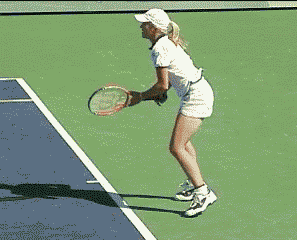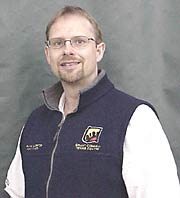|
TennisOne Lessons Progressive Tennis Innovation in Development for 5-9 Year-Olds Wayne Elderton
A revolution is starting to take hold on courts around the world. Most commonly called ‘Progressive Tennis’, it is a natural application of the Game-based approach (GBA) as applied to under 10’s. Pioneered in European countries like France and Belgium, it is now the development method of choice for the majority of the world’s leading tennis nations. None other than the likes of Rodger Federer is the spokesperson for Progressive Tennis in his home country of Switzerland. Belgium is recognized as the world leader in Progressive Tennis development with their program spawning players like Justine Henin and Olivier Rochus. The System The system modifies four basic elements of the game to increase success and accelerate development. These then become the four Integrated Components of the system:
Progressive Tennis has 3 stages (most countries focus on the first two): Stage 1: Called 12 meter tennis in Europe, 36 foot tennis in the US, and ½ Court Tennis in Canada. It is usually color-coded as Red in promotional materials.This scale is for 5-7 year olds and is commonly played sideways across the court. Stage 2: Called 18 meter tennis in Europe, 60 foot tennis in the US and ¾ Court Tennis in Canada. It is typically color-coded Orange in promotional materials. This scale is for 7-9 year olds and is played with a shorter baseline and often narrower sidelines (depending on the country).
Stage 3: The transition onto the full court with a modified ball. Typically color-coded Green. What’s Old is New Again Most North American Pros who are ‘in the know’ will say, “So what’s new, I have been using modified equipment for a while?” For example, both US coaching certification organizations have modified equipment programs. Here are some questions to evaluate if a coach is actually using the Progressive Tennis system. The following points also outline some ‘new’ advantages that even coaches who have used this equipment before aren’t generally familiar with: The key to this system is that, “the sum is greater than all the parts.” To truly realize all the benefits of Progressive Tennis, all four Integrated Components must be used. Using all four Integrated Components maximizes the benefits the system affords.
Competition: “Do I have regular competition for players on ½ and ¾ Court?” The key to this system is the competition. Scaled tennis allows participants to actually play (very difficult for younger beginners with regulation courts and equipment). There should be ‘in-house’ league play as well as tournaments in cities and regionally (and possibly at the national level). For example, in Belgium, there is a circuit of Stage 1 events around the country (advertised just like the junior tournaments in all USTA sections). Competition (if it is in fun, non-elimination formats) drives participation and lessons. It gives coaches something to teach towards. For example, the reason most kids are in Soccer practice during the week is to apply their skills to the game on the weekend. This is the model (game-practice-game) used by most successful sports as it keeps learning relevant. For the most part, coaches used the equipment as a novelty. It was safe and fun. They also typically ‘dabbled’ with the equipment with the goal to get to ‘real’ tennis as soon as possible. The advantage of Progressive Tennis is to keep the players at the appropriate scale longer. For example, a Stage 1 player entering the system at 5 years old would stay for 2 years at the ½ Court length. This would allow coaches to implement more professional long-term development with solid annual plans (there is also great advantages for short-term programs and camps).
During those 2 years, all the players group lessons, private lessons, leagues and tournaments, would be on the ½ Court. The result, consistent and appropriate development. The equipment makes it easier to develop the foundation of an advanced adult game. Tactics can be learned and implemented easier because of the court scale. Technique can be developed faster as well. Don’t get me wrong, these things can, and have, been developed with regulation equipment for decades. What is being revealed is that masses of kids can develop more successfully and to more masterful levels with the system. Not just the stereotypical talented kid with the overly committed parent feeding millions of balls daily. In other words, more kids, playing at higher levels, at younger ages. Barriers to Growth In Canada, we have seen great improvements in the quantity and quality of players by applying the system. Not to be left behind, the USTA has also done their own research and engaged experts in the field. They are rolling out their “36/60” initiative in 2008 to launch Progressive Tennis across the country. Progressive Tennis is also a main component in the International Tennis Federation's (ITF) world-wide tennis initiative, Tennis...Play and Stay.
Every country that has applied the system has experienced very positive results along with common growing pains. In regards to these growing pains, the first and foremost barrier is the parents and coaches who don’t catch the vision. Typically, there are two prevalent attitudes that hinder the development of young kids:
Big Tennis Imagine you get to play a new game called, “Big Tennis.” The playing area of the game is a singles court 120 feet long (the length to the typical back fence of a regulation court) with sidelines 3 feet outside the regulation doubles court. The net would be 4.5 feet high. Scale Appropriate Principle Scale appropriate development is a principle used in many sports. No one puts kids on full-size soccer pitches or baseball diamonds. T-Ball was one of the first innovations to make baseball development more accessible and practical. The sizes of baseballs, soccer balls, bats, hockey sticks, and a myriad of other equipment is scaled in all the major sports. These sports accept the science of growth and maturity stages. Conclusion Hopefully, seeing the videos of the Progressive Tennis players and, reading about the principles and science involved, you will be encouraged to seek out this kind of program (if you have a child learning to play tennis) or, if you are a coach, you will feel comfortable enough to give it a shot. In subsequent articles, we will look at the ‘hows’ of developing tactics and techniques in a GBA using Progressive Tennis. Your comments are welcome. Let us know what you think about Wayne Elderton's article by emailing us here at TennisOne.
|


 Wayne Elderton
Wayne Elderton